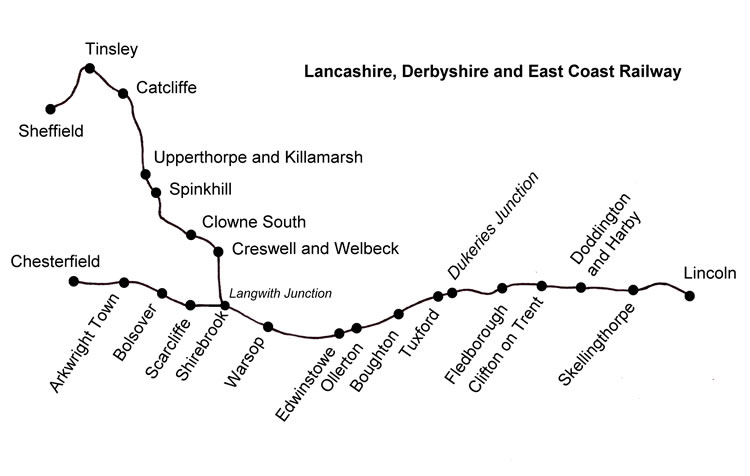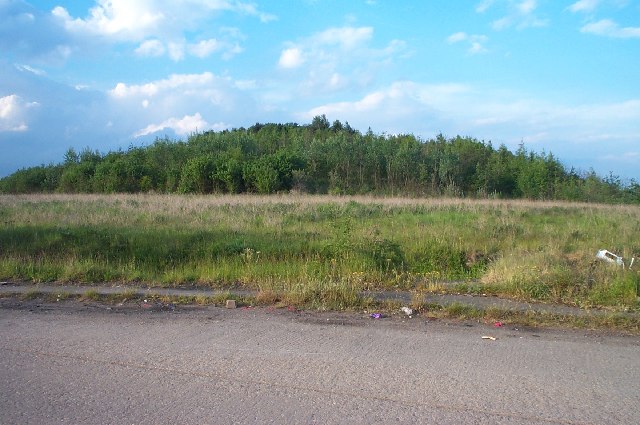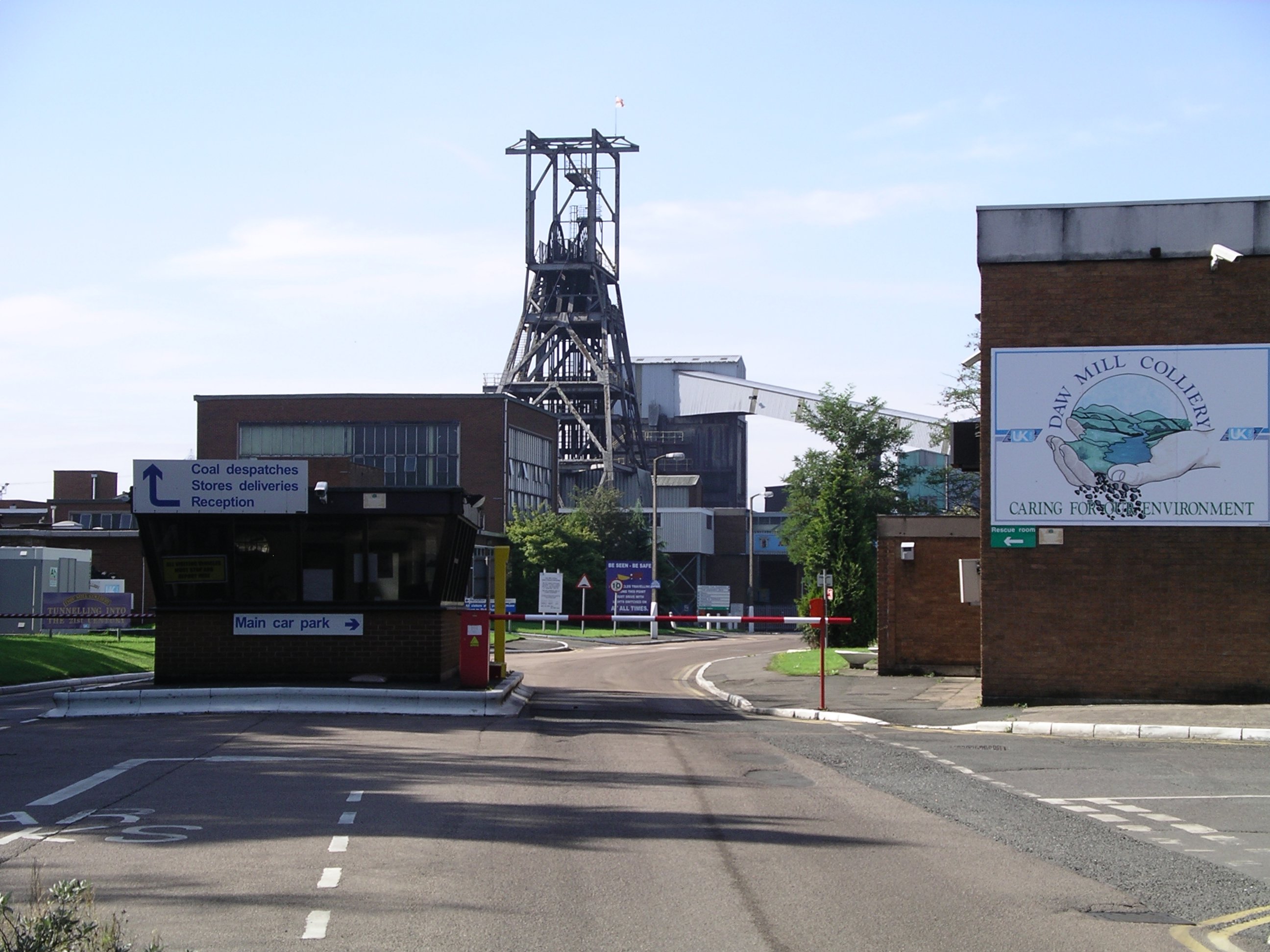|
Warsop Railway Station
Warsop railway station is a former railway station in Market Warsop, Nottinghamshire, England. History The station was opened by the Lancashire, Derbyshire & East Coast Railway in March 1897 and closed by British Railways in 1955. The station building made use of the LD&ECR's standard modular architecture. After leaving Shirebrook North station, the line crossed the Midland Nottingham to Worksop line (now the Robin Hood Line and passed the LD&ECR Warsop yard near Warsop Junction. These yards are still in use, currently by DB Cargo UK. To the north was a branch to Warsop Main Colliery with extensive marshalling yards, now closed. Shortly after this, in the days when the line was built, the line ran into countryside, crossing Warsop Vale, and arrived at Warsop station. These were in the days before the deep mines appeared penetrating the limestone cap. Between Warsop and Edwinstowe the line climbed from the valley of the River Meden, heading for that of the River Maun. Th ... [...More Info...] [...Related Items...] OR: [Wikipedia] [Google] [Baidu] |
Market Warsop
Warsop is a town and civil parish in the Mansfield district, Nottinghamshire, England, on the outskirts of the remnants of Sherwood Forest.OS Explorer Map 270: Sherwood Forest: (1:25 000): At the 2001 census it had a population of 12,365, reducing to 11,999 at the 2011 Census including Church Warsop, Meden Vale and Spion Kop. Governance The parish was an urban district in Nottinghamshire until 1974, when it joined with Mansfield Borough and Woodhouse Urban District Council to form Mansfield District Council. Warsop retains a council, as a successor parish, including the localities of Market Warsop, Church Warsop, Meden Vale, Warsop Vale and Spion Kop. The council is based at Warsop Town Hall. After re-alignment of local wards within Mansfield District Council before the 2011 local elections to achieve a standard format of one councillor-per-ward, Warsop has four designated areas named as Warsop Carrs, Netherfield, Market Warsop and Meden. Warsop is a part of the Mansfield Pa ... [...More Info...] [...Related Items...] OR: [Wikipedia] [Google] [Baidu] |
Warsop Vale
Warsop Vale is a small village in the Mansfield district of western Nottinghamshire, England. It is north west of London, north of the county town and city of Nottingham, and north of the town of Mansfield. It is in the civil parish of Warsop. Warsop Vale's heritage is primarily as a former mining village. It lies in the very picturesque area known as the Dukeries and is easily accessible to Clumber Park, Thoresby Park and hall, Rufford Park and the Earl of Portland estate of Welbeck, together all part of Sherwood Forest. Geography Location Warsop Vale is surrounded by the following local Nottinghamshire areas: * Nether Langwith and Cuckney to the north * Sookholme to the south * Church Warsop and Market Warsop to the east * Shirebrook in Derbyshire to the west This area lies in the north west of the district and west of Nottinghamshire county, as well as being close to the Derbyshire boundary. The core of the hamlet is accessed from the B6031 Church Warsop-Shirebr ... [...More Info...] [...Related Items...] OR: [Wikipedia] [Google] [Baidu] |
Clophill
Clophill is a village and civil parish clustered on the north bank of the River Flit, Bedfordshire, England. It is recorded in the Domesday Book of 1086 as ''Clopelle''. "Clop" likely means 'tree-stump' in Old English. However, it also has cognate terms for clay, with which the soil of mid Bedfordshire is rich. Extent and demography In the 1851 census, the men of the parish numbered 560; of these, 238 were agricultural labourers; women numbered. In the 2011 Census the population was 1,750. The contiguous housing of Clophill Road and its side streets falls into the civil and ecclesiastical parishes of Maulden. Church St Mary's old church The old St Mary's Church was built around 1350, and replaced by a new church in the 1840s (250 m SSW). It gradually fell into ruin, and as an inactive church, had restoration carried out for secular purposes in the early 2010s. Active churches The new St Mary's church is in the High Street, built 1848–1849. The current rector i ... [...More Info...] [...Related Items...] OR: [Wikipedia] [Google] [Baidu] |
High Marnham Test Track
The High Marnham Test Track is a linear railway test track created in 2009 and centred on Lodge Lane, Tuxford, in Nottinghamshire in the United Kingdom. It houses Network Rail's Rail Innovation & Development Centre (RIDC), originally known as the Rail Vehicle Development Centre (RVDC). The main route is approximately long and rated for speeds up to . It is primarily formed of a former section of the Lancashire, Derbyshire and East Coast Railway running between Thoresby Colliery Junction at the western end, and High Marnham Power Station at the eastern end. Additionally a branchline diverges northwards over the Bevercotes Colliery Branch via Boughton Brake Tunnel to Bevercotes. The main test track passes on a bridge directly over the East Coast Main Line, at the location of the former Dukeries Junction interchange station, but without a rail connection being provided. Instead the test track is accessed from the national British railway network via Shirebrook Junct ... [...More Info...] [...Related Items...] OR: [Wikipedia] [Google] [Baidu] |
UK Coal
UK Coal Production Ltd, formerly UK Coal plc, was the largest coal mining business in the United Kingdom. The company was based in Harworth, in Nottinghamshire. The company was a constituent of the FTSE 250 Index. The successor company that contains the former property division, Harworth Group, is still listed on the London Stock Exchange. History The predecessor company of UK Coal was founded by Richard J. Budge in 1974 as ''RJB Mining''. In 1994, following the privatisation of the UK mining industry, it grew fivefold with the acquisition of British Coal's core activities. It changed its name to UK Coal in 2001 after the retirement of its founder, having acquired UK Coal plc. Former operations At year end 2008, the company estimated coal reserves and resources of 105 Mt at the mines, of which 45 Mt was accessible under existing five year mining and investment plans. Its most important customers were electricity generators. In 2010 the company proposed a series of ... [...More Info...] [...Related Items...] OR: [Wikipedia] [Google] [Baidu] |
Radford Railway Station
Radford railway station was on the Midland Main Line and Robin Hood Line in Radford, Nottingham. History It was opened by the Midland Railway on 2 October 1848. Three passenger trains a day in each direction were provided from Monday to Saturday with two on Sundays. The fare from Nottingham to Radford was 9d. in first class (), 6d in second class (), and 4d in third class (). In 1870 the Midland Railway approved the construction of the Radford to Trowell line which started at a junction just north of Radford station. Along with the Ambergate to Codnor Park line constructed at the same time, its purpose was to route Lancashire freight traffic via Nottingham to avoid the bottleneck of Derby. The line was nearly 5 miles in length and the contractor was Messrs Eckersley and Bayliss of Derby. Some labour force issues delayed completion of the line until 1874. It formally opened on 1 May 1875. and also served Wollaton Colliery and later Trowell Moor Colliery. It closed on 12 Octobe ... [...More Info...] [...Related Items...] OR: [Wikipedia] [Google] [Baidu] |
Mansfield Railway Station (England)
Mansfield railway station is a railway station which serves the town of Mansfield in Nottinghamshire, England. Alternatively it is named Mansfield Town, to distinguish itself from the GCR's former Mansfield Central and Mansfield Woodhouse's station. The station is north of Nottingham on the Robin Hood Line, and is managed by East Midlands Railway. The station building is Grade II listed. History The town was originally the terminus of the Mansfield and Pinxton Railway, built in 1819. It was bought by the Midland Railway, which used the final section to extend its new Leen Valley line to the present station in 1849. The station opened for passenger traffic without ceremony on Tuesday 9 October 1849. The line suffered from some teething problems in its early days. The ''Derby Mercury'' of 24 October 1849 criticised the quality of construction noting that: engines have been off the line in the station yard at Mansfield several times since the opening on Tuesday week. The curves ... [...More Info...] [...Related Items...] OR: [Wikipedia] [Google] [Baidu] |
Lincoln, England
Lincoln () is a cathedral city, a non-metropolitan district, and the county town of Lincolnshire, England. In the 2021 Census, the Lincoln district had a population of 103,813. The 2011 census gave the Lincoln Urban Area, urban area of Lincoln, including North Hykeham and Waddington, Lincolnshire, Waddington, a population of 115,000. Roman Britain, Roman ''Lindum Colonia'' developed from an Iron Age settlement on the River Witham. Landmarks include Lincoln Cathedral (English Gothic architecture; for over 200 years the world's tallest building) and the 11th-century Norman architecture, Norman Lincoln Castle. The city hosts the University of Lincoln, Bishop Grosseteste University, Lincoln City F.C., Lincoln City FC and Lincoln United F.C., Lincoln United FC. Lincoln is the largest settlement in Lincolnshire, with the towns of Grimsby second largest and Scunthorpe third. History Earliest history: ''Lincoln'' The earliest origins of Lincoln can be traced to remains of an Iron Ag ... [...More Info...] [...Related Items...] OR: [Wikipedia] [Google] [Baidu] |
Mansfield Central Railway Station
Mansfield Central is a former railway station that served the town of Mansfield, Nottinghamshire. History The station was opened in 1917 by the Mansfield Railway, along with and . The line, and its stations, was worked by the Great Central Railway and became part of the LNER in 1923 and subsequently British Railways in 1948. Most regular passenger trains plied between and Mansfield Central, with some extending to and . In the station's early years some services plied between Mansfield Central and stations between and . Timetabled services ceased on 3 January 1956, though Summer weekend excursion traffic to Scarborough, Cleethorpes, Skegness and Mablethorpe continued until 8 September 1962. The line through the station was closed on 7 January 1968 and subsequently lifted. The station and its associated earthworks were razed to the ground in 1972. References Sources * * * * * * * * External linksMansfield Central railway station on navigable 1947 O.S. Map''np ... [...More Info...] [...Related Items...] OR: [Wikipedia] [Google] [Baidu] |
William Cavendish-Bentinck, 6th Duke Of Portland
William John Arthur Charles James Cavendish-Bentinck, 6th Duke of Portland, (28 December 1857 – 26 April 1943), known as William Cavendish-Bentinck until 1879, was a British landowner, courtier, and Conservative politician. He notably served as Master of the Horse between 1886 and 1892 and again between 1895 and 1905. Background and education Portland was the son of Lieutenant-General Arthur Cavendish-Bentinck by his first wife Elizabeth Sophia Hawkins-Whitshed, daughter of Sir St Vincent Hawkins-Whitshed, 2nd Baronet and granddaughter of Admiral Sir James Hawkins-Whitshed, 1st Baronet. His paternal grandparents were Lord Charles Bentinck and his second wife Anne Wellesley, the natural daughter of Richard Wellesley, 1st Marquess Wellesley, and a niece of Arthur Wellesley, 1st Duke of Wellington. Lord Charles was the third son of Prime Minister William Cavendish-Bentinck, 3rd Duke of Portland by his wife Lady Dorothy Cavendish, daughter of William Cavendish, 4th Duke of D ... [...More Info...] [...Related Items...] OR: [Wikipedia] [Google] [Baidu] |
Mansfield
Mansfield is a market town and the administrative centre of Mansfield District in Nottinghamshire, England. It is the largest town in the wider Mansfield Urban Area (followed by Sutton-in-Ashfield). It gained the Royal Charter of a market town in 1227. The town lies in the Maun Valley, north of Nottingham and near Sutton-in-Ashfield. Most of the 109,000 population live in the town itself (including Mansfield Woodhouse), with Warsop as a secondary centre. Mansfield is the one local authority in Nottinghamshire with a publicly elected mayor. History Roman to Mediaeval Period Settlement dates to the Roman period. Major Hayman Rooke in 1787 discovered a villa between Mansfield Woodhouse and Pleasley; a cache of denarii was found near King's Mill in 1849. Early English royalty stayed there; Mercian Kings used it as a base to hunt in Sherwood Forest. The Royal Manor of Mansfield was held by the King. In 1042 Edward the Confessor possessed a manor in Mansfield. William the Conqu ... [...More Info...] [...Related Items...] OR: [Wikipedia] [Google] [Baidu] |
The Dukeries
The Dukeries is an area of the county of Nottinghamshire so called because it contained four ducal seats. It is south of Worksop, which has been called its "gateway". The area was included within the ancient Sherwood Forest. The ducal seats were: * Worksop Manor: a home of the Dukes of Norfolk, and nearest to Worksop; * Welbeck Abbey: seat of the Dukes of Portland; * Thoresby Hall: seat of the Dukes of Kingston (later of the Earls Manvers); and * Clumber House: seat of the Dukes of Newcastle, since demolished. A fifth large country house, Rufford Abbey in this area belonged to the 2nd to 8th Savile baronets, their later-to-be ennobled heirs (with the territorial designation of Halifax), then from 1888 until 1938 to 1st to 3rd Lords Savile. Welbeck Woodhouse is a further notable mansion, in the former park (grounds) of Welbeck Abbey and was built by Lord Titchfield in the 1930s. Character The Dukeries saw four ducal families close together among the less than twenty current ( ... [...More Info...] [...Related Items...] OR: [Wikipedia] [Google] [Baidu] |










